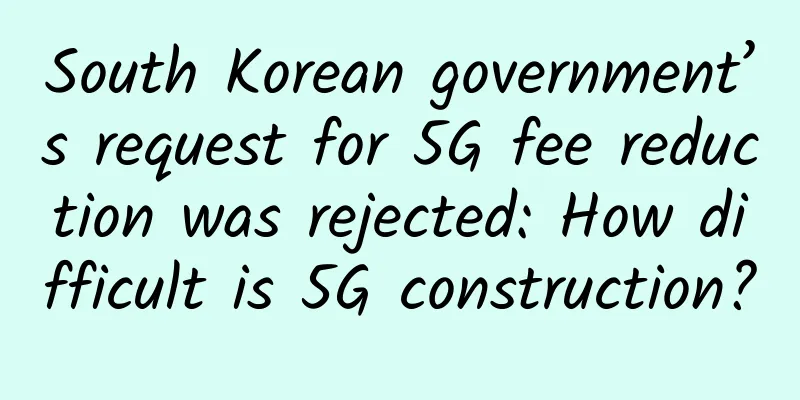South Korean government’s request for 5G fee reduction was rejected: How difficult is 5G construction?

|
Increasing speed and reducing fees is Premier Li's request to the three major operators. Under this requirement, China's overall network speed has been greatly improved and fees have been further reduced. This measure has effectively promoted the development of China's Internet era, allowing everyone to see the outside world through the Internet.
In South Korea, the South Korean government proposed to reduce fees to the three major operators, but was rejected by the three operators at the same time. This was a special feeling for the South Korean government. South Korean telecom operators believe that the current stage of focusing on 5G network investment, the primary task is to expand the user base, is not a good time to reduce tariffs, the three major telecom CEOs are currently only willing to promise "will discuss reducing tariffs." It is reported that the 5G packages currently offered by South Korean operators start at 55,000 won per month, equivalent to RMB 328. The Ministry of Science, Technology, Information and Communications of South Korea believes that 5G is about to enter the popularization stage, and 5G charges are expected to drop to 30,000 to 40,000 won. How expensive is 5G construction? According to relevant data, the construction cost of a single 4G network base station is about 300,000 yuan. As of July 2019, the Ministry of Industry and Information Technology has counted more than 4.5 million 4G base stations, and the coverage radius of each base station is 1-3 kilometers. And this is just a drop in the ocean for 5G. The coverage area radius of a 5G base station is 300-500 meters. Under the same environment, at least three 5G base stations are needed to cover the area of a 4G base station. However, according to relevant data, in the commercial stage of 5G, the price of a single base station is about 500,000-600,000 yuan. With the maturity of technology and the scale of the base station industry, the price of a single base station is expected to be reduced to 400,000 yuan. However, 5G construction is not just about base station construction, it also involves multiple parts such as transmission network and core network. If this part of the cost is allocated to a single base station, the price will be about RMB 50,000 to 100,000. To put it simply, building a complete 5G network in China requires millions of 5G macro base stations and 20 million small base stations. The investment cost is conservatively estimated to be 3 trillion yuan, which is a huge burden for operators. At the same time, the cost of building the 4G network has not yet been fully recovered, which shows why Korean operators chose to reject the Korean government. Is 5G construction really necessary? When 4G has not yet paid back its investment, vigorously building 5G networks does not seem to be in line with the development of the market economy. However, at the national level, once 5G construction is completed, it will further promote the rapid development of various industries, and it is not just "faster" in appearance to ordinary people. With the advent of the era of big data and cloud computing, people no longer rely solely on local hardware for calculations when processing data. Instead, they upload various types of data through the Internet, calculate them on cloud computers, and then feed them back to local computers for processing. The main advantage of uploading to the cloud is that it can effectively save the R&D and production costs of local hardware and weaken the demand for local hardware. To put it simply, the local computing part is changed to be performed in the cloud, and the cloud provider can change the computing power and algorithm according to the needs of the user, and feed back the processed data to the user in real time for the next step. In this process, network transmission becomes the most core part - once the network transmission is delayed, it will directly cause the terminal to freeze and other phenomena. The emergence of 5G will change this situation. Compared with 4G, 5G has the characteristics of high speed and high frequency. Based on these characteristics, 5G network can bring network transmission with nearly zero delay to end users. However, 5G is not perfect. Due to its high-frequency transmission characteristics, its penetration is poor, especially in urban environments. Due to the characteristics of buildings, the 5G signal transmission process will be blocked, so more repeaters or couplers and other equipment need to be built. Once 5G construction is completed, it will drive various industries to get better at interconnection. China's determination to build 5G In order to achieve rapid development of various industries, China has twice asked the three major operators to reduce fees. Under this requirement, the three major operators have successively released 5G tariffs after the advent of 5G. Compared with South Korea, China's 5G tariffs are about half of South Korea's, or even lower. (Photo source: China Unicom official website) (Image source: China Mobile official website) In South Korea, the three major telecom operators, Korea Telecom, SK Telecom and LG U+, released 5G packages of different levels at the beginning of this year, with monthly fees ranging from 55,000 won (about 325 yuan) to 130,000 won (about 769 yuan). The three domestic operators have lowered their rates to allow more companies and individuals to use 5G networks, which will be conducive to the rapid development of the domestic 5G industry. For enterprises, the application of 5G networks will further stimulate user demand and thus choose 5G. Expanding 5G and deploying 6G However, in an environment where 5G has just been commercialized, the construction of 6G networks has also been put on the agenda. It is understood that 6G networks will be committed to creating a fully connected communication world that integrates ground communications, satellite communications, and marine communications. Deserts, uninhabited areas, oceans and other "blind spots" of current mobile communications are expected to achieve signal coverage. But for now, if 4G is aimed at consumers, then 5G is the preliminary infrastructure of Industry 4.0. Although the application of 6G network is still unknown, according to relevant experts, 6G will be used in space communication, intelligent interaction, tactile Internet, emotional and tactile communication, multi-sensory mixed reality, machine collaboration, fully automatic transportation and other scenarios in the future. Compared with 5G, the transmission speed of 6G network is 100 times that of 5G, but for now, as Yu Chengdong said, "6G is under development and it is estimated that it will take another 10 years. We are currently doing technical research and standard research, and it has not yet reached the commercial stage." Perhaps when 6G arrives, the world's industry will usher in a new development situation because of 6G! |
<<: TCP retransmission problem troubleshooting ideas and practices
>>: 5G is not only faster, but also safer!
Recommend
Report: 5G will become one of the most influential technologies from 2020 to 2025
On October 26, foreign media reported that accord...
Here is everything you want to know about 5G progress and next steps
The progress of 5G has always been a key topic of...
IPv4 addresses are exhausted. Let’s discuss IPv6 penetration and IP migration complexity.
[[283967]] As a basic resource, IPv4 has supporte...
CloudServer: $10/year-1GB/20GB/1TB/Los Angeles & Chicago & New York data centers
Netizens reported that CloudServer has a special ...
Huawei Shanghai 5G+XR Cloud Innovation Center goes online to accelerate the activation of Shanghai's 5G innovation value
Recently, Huawei's 5G+XR Cloud Industry Summi...
Justhost newly launched New York VPS, multiple data centers in the United States/Russia/UK/Germany/Hong Kong, China, etc. starting from $1.16/month
JustHost.asia sent information about the new VPS ...
WiFi will be replaced? Not 5G
The pace of life of modern people is getting fast...
Under the dual system of security and safety protection, Ruishu Dynamic Security Hyper-convergence helps enterprises implement "three transformations and six defenses"
In order to further strengthen the security of my...
Explore F5G industry scenario application practices and promote the digital transformation of enterprises into a new journey
More and more industry cases tell us that F5G (fi...
Karamay: Huawei's first cloud strategic cooperation city in the world
Karamay is a desert city that was born and prospe...
The number of 5G package users exceeds 600 million, and the profits of the three major operators have skyrocketed. Is 5G starting to make money?
In June 2019, the four major operators obtained 5...
OneTechCloud starts at 30% off, Hong Kong BGP/CN2, US CN2, CN2 GIA high defense optional
OneTechCloud (Yikeyun) continues to offer promoti...
How 5G can help realize massive IoT
When discussing the coming 5G era, attention is o...
After reading this article, you will regret not visiting the exhibition area of Huawei Eco Partner Conference 2019
[51CTO.com original article] After reading this a...
spinservers: Mid-Autumn Festival promotion, VPS 60% off 2G memory package from $5.6/month, dual E5+256G memory dedicated server from $199/month
spinservers launched a special promotion during t...









